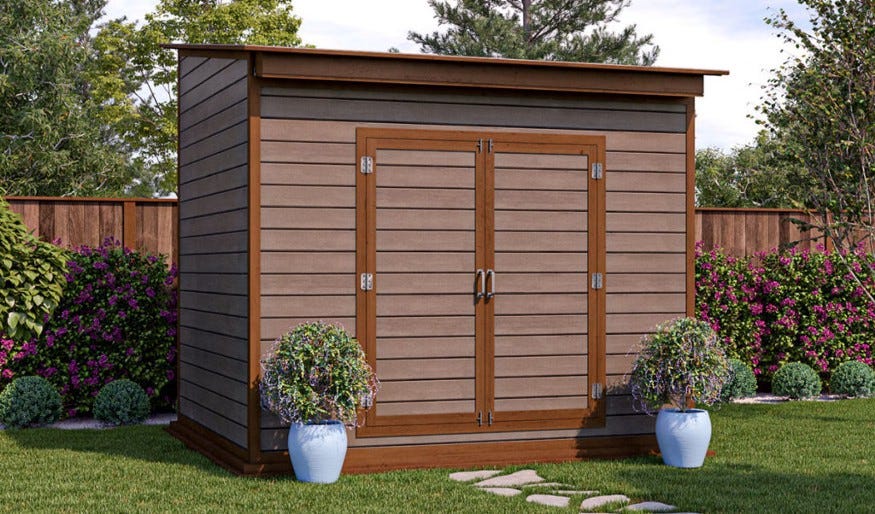
Alright, so you've decided you need a storage shed. Maybe your garage is overflowing, you've got a ton of gardening tools taking over the patio, or you just have a serious case of "stuffitis". Whatever the reason, it's time to get organized and a storage shed is the perfect solution!
But before you start dreaming of a fancy, multi-story shed with a built-in bar (hey, a guy can dream!), let's talk budget. Sheds come in all shapes, sizes, and materials, and the price tag can vary wildly.
So, how do you choose the perfect storage shed plans for your budget?
It's all about finding the sweet spot between your storage needs, your desired features, and your bank account. Let's break it down:
1. Define Your Storage Needs:
What are you storing? Are we talking lawn mowers and garden tools? Seasonal decorations? Bikes and kayaks? Knowing what you need to store will help you determine the size and features you need.
How much space do you need? Do you want a small, 8x8 shed for basic tools, or a larger, 10x12 shed for all your hobbies and equipment?
Do you need any specific features? A workbench? Shelving? Windows for light? Think about what would make your shed the most functional and efficient for your needs.
2. Choose Your Material:
Wood: Classic and affordable, wood sheds offer a traditional look and feel. However, they require regular maintenance like painting and sealing to prevent rot and weather damage.
Metal: Durable and low-maintenance, metal sheds are resistant to rust, insects, and rot. They often come in a variety of colors and can withstand harsher weather conditions.
Vinyl: This option is super low-maintenance, offering a sleek modern look. It's resistant to rot, insects, and fading, making it a great choice for those seeking a worry-free option.
3. Consider Your Budget:
DIY vs. Pre-built: Building your own shed can save you money, but it requires time, skills, and tools. Pre-built sheds offer a convenient and often quicker option, though they usually come with a higher price tag.
Kit vs. Assembled: Kits are a good middle ground, offering a more affordable option than fully assembled sheds. They usually require some assembly, but they can be easier to handle and transport than pre-built sheds.
Material Costs: Wood is generally the most affordable material, followed by metal and then vinyl. Keep in mind that cheaper materials might require more maintenance in the long run.
4. Explore Your Options:
Local Shed Builders: Check with local businesses in your area that specialize in custom shed building. They can help you design a shed that perfectly meets your needs and budget.
Big Box Stores: Stores like Home Depot, Lowe's, and Menards offer a wide range of pre-built sheds and kits at various price points.
Online Retailers: Websites like Amazon, Wayfair, and Sheds.com offer a vast selection of sheds, including customizable options and pre-built models.
5. Don't Forget the Extras:
Foundation: A proper foundation will ensure your shed lasts for years to come. Depending on your shed size and location, you might need a concrete slab, wooden piers, or a gravel base.
Permits: Check with your local building department for any necessary permits or zoning regulations.
Delivery and Installation: Many shed providers offer delivery and installation services, which can be a huge time-saver and convenience.
So, what's the best way to choose the perfect shed for your budget?
Start by setting a budget. How much are you comfortable spending? Be realistic and factor in all the costs, including materials, foundation, permits, and delivery/installation.
Think about your needs and priorities. What are you willing to compromise on? Can you DIY to save money? Do you need a fancy shed or a simple, functional one?
Get multiple quotes. Don't settle for the first shed you see. Compare prices and features from different providers to find the best value for your money.
Read reviews. See what other customers have to say about different shed manufacturers and providers. This can give you valuable insights into their quality, customer service, and overall value.
Remember, finding the perfect storage shed is a journey, not a race. Take your time, explore your options, and don't be afraid to ask questions. With a little research and planning, you can find the perfect shed that fits your budget and helps you reclaim your space!
Here are a few additional tips to help you save money:
Shop around for deals. Many stores offer discounts and promotions throughout the year, especially during holidays and seasonal sales.
Consider buying a used shed. If you're on a tight budget, a used shed can be a great option. Look for sheds in good condition that have been properly maintained.
Do it yourself whenever possible. Building a shed from scratch can save you a lot of money, even if you need to hire some help with certain tasks.
Finally, remember that a shed is an investment. It's not just a place to store your stuff; it's an extension of your home that can add value and functionality to your property. So, choose wisely, and enjoy your new storage solution!
0 comments:
Post a Comment
Note: Only a member of this blog may post a comment.